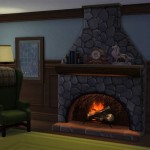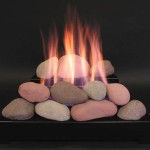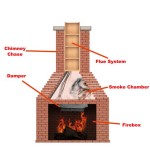Converting a Gas Log Fireplace to Wood Burning: A Comprehensive Guide
The allure of a crackling wood-burning fire remains a strong draw for many homeowners. While gas log fireplaces offer convenience and ease of use, they lack the authentic ambiance and radiant heat produced by burning wood. Converting a gas log fireplace to a wood-burning fireplace is a complex project that necessitates careful assessment, planning, and execution. Safety and adherence to local building codes are paramount, ensuring that the conversion is performed correctly and the fireplace operates safely.
Prior to initiating any conversion work, a thorough inspection of the existing fireplace and chimney system is essential. This inspection should be conducted by a qualified chimney sweep or certified professional. The purpose is to determine the structural integrity of the firebox, flue, and chimney. Cracks, deterioration, or other damage can compromise the safety and efficiency of a wood-burning fireplace. The inspection will identify any necessary repairs or modifications required to accommodate the increased heat and byproducts of burning wood.
The compatibility of the existing firebox with wood burning is a critical factor. Gas fireplaces are typically designed with thinner fireboxes than their wood-burning counterparts. The higher temperatures generated by burning wood can cause warping, cracking, or even complete failure of a firebox intended solely for gas logs. A professional assessment will determine if the existing firebox is adequately constructed for wood burning or if it needs reinforcement or replacement.
Chimney flue sizing is another crucial consideration. The flue must be appropriately sized to efficiently vent the smoke and combustion gases produced by burning wood. An undersized flue can lead to poor drafting, resulting in smoke spillage into the living space and an increased risk of carbon monoxide poisoning. Conversely, an oversized flue can result in rapid heat loss and inefficient burning. A professional will calculate the appropriate flue size based on the dimensions of the firebox opening and the height of the chimney.
Key Point 1: Assessing Fireplace and Chimney Suitability
The initial step in converting a gas log fireplace to wood-burning involves a comprehensive assessment of the existing structure. This assessment determines whether the fireplace and chimney are structurally sound and capable of handling the demands of burning wood. Several factors contribute to this determination, including the firebox construction, chimney flue size, and overall condition of the system.
The firebox, the enclosed area where the fire burns, must be constructed of fire-resistant materials such as firebrick or cast iron. These materials are designed to withstand the intense heat generated by burning wood without cracking or deteriorating. The thickness of the firebox walls is also important. Thinner fireboxes, commonly found in gas fireplaces, may not be sufficient to contain the heat of a wood fire, potentially leading to structural damage or even a fire hazard.
The chimney flue is the passageway through which smoke and combustion gases are vented to the outside. The flue must be properly sized to ensure adequate draft, which is the upward flow of air that draws smoke out of the fireplace. An undersized flue restricts airflow, causing smoke to back up into the room. An oversized flue, on the other hand, allows heat to escape too quickly, resulting in inefficient burning and increased fuel consumption. A professional chimney sweep can assess the flue size and determine if it is appropriate for wood burning.
The overall condition of the chimney is also a critical factor. Cracks, deterioration, or blockages in the chimney can compromise its ability to vent smoke and combustion gases safely. Regular chimney inspections and cleaning are essential to maintain its integrity and prevent potential hazards. If the chimney is found to be damaged, it must be repaired or replaced before converting the fireplace to wood burning.
In some cases, the existing fireplace and chimney may not be suitable for wood burning without significant modifications. This may involve reinforcing the firebox, relining the chimney flue, or even replacing the entire fireplace system. A professional assessment will provide a clear understanding of the necessary modifications and their associated costs.
Key Point 2: Necessary Modifications and Installations
Based on the initial assessment, specific modifications and installations may be required to ensure the safe and efficient operation of a wood-burning fireplace. These modifications can range from minor repairs to major structural alterations. Proper planning and execution are crucial to ensure that the conversion meets all safety standards and building codes.
One common modification is the installation of a chimney liner. A chimney liner is a tube that is inserted into the existing chimney flue to provide a smooth, airtight passageway for smoke and combustion gases. Chimney liners are typically made of stainless steel or clay tile and are available in various sizes and configurations. A liner may be necessary if the existing flue is damaged, undersized, or constructed of unsuitable materials.
Another potential modification is the reinforcement or replacement of the firebox. If the existing firebox is deemed too thin or structurally unsound for wood burning, it may need to be reinforced with additional firebrick or completely replaced with a heavier-duty firebox. This is a significant undertaking that requires skilled craftsmanship and specialized tools.
The installation of a damper is also essential for regulating airflow and preventing heat loss when the fireplace is not in use. The damper is a metal plate that can be opened or closed to control the flow of air through the chimney. A properly functioning damper is crucial for maintaining energy efficiency and preventing drafts.
In addition to structural modifications, certain safety features should be installed as part of the conversion process. These include a smoke detector and carbon monoxide detector, which provide early warning of potential hazards. It is also advisable to install a fire screen to prevent sparks and embers from escaping the fireplace.
The selection of appropriate wood-burning tools and accessories is also important. These include a poker, shovel, tongs, and a grate to support the wood. These tools are essential for safely and efficiently managing the fire.
Key Point 3: Understanding Building Codes and Safety Regulations
Converting a gas log fireplace to wood burning is subject to local building codes and safety regulations. These regulations are designed to protect homeowners and the community from fire hazards and other potential dangers. It is imperative to understand and comply with all applicable codes before initiating any conversion work.
Building codes typically specify requirements for fireplace construction, chimney flue sizing, and ventilation. These requirements vary depending on the location and the type of fireplace being installed. It is essential to consult with the local building department to obtain a copy of the applicable codes and ensure that the conversion meets all requirements.
Safety regulations also address the use of wood-burning fireplaces. These regulations may restrict the types of wood that can be burned, the size of the fire that can be built, and the frequency of chimney cleaning. It is important to follow these regulations to prevent creosote buildup, which is a flammable substance that can accumulate in the chimney and potentially cause a fire.
Obtaining the necessary permits is another important aspect of complying with building codes. Permits are typically required for any significant modifications to a fireplace or chimney. Applying for a permit involves submitting plans and specifications to the building department for review and approval. This process ensures that the conversion meets all applicable codes and safety standards.
Even after the conversion is complete, it is essential to maintain the fireplace and chimney in good working order. Regular inspections and cleaning are crucial for preventing potential hazards and ensuring the safe operation of the fireplace. A qualified chimney sweep should be hired to inspect the chimney at least once a year and clean it as needed.
Ignoring building codes and safety regulations can have serious consequences. Violations can result in fines, legal action, and even the potential for a fire or other safety hazard. Compliance with these regulations is essential for protecting the safety and well-being of homeowners and the community.
In summary, converting a gas log fireplace to a wood-burning fireplace requires careful planning, assessment, and execution. Understanding the structural limitations of the existing fireplace, modifications required and adherence to the local building codes are paramount to ensure safe and efficient operation. Consulting with qualified professionals throughout the process is highly recommended to ensure that the conversion is performed correctly and in compliance with all applicable regulations. A meticulous approach will allow homeowners to enjoy the warmth and ambiance of a real wood-burning fire safely for years to come.

Want To Convert Gas Wood Fireplace Full Service Chimney

Gas To Wood Fireplace Conversion Overland Park Ks Firplace Service

Want To Convert Gas Wood Fireplace Full Service Chimney

Wood Fireplaces Gas Conversion That Counts

Can You Convert A Gas Fireplace To Wood Burning Stove Direct Stoves Resources
Converting A Wood Burning Fireplace Into Gas Heat Glo

Wood Burner Conversion New Jersey Fireplaces Kjb

Wood To Gas Fireplace Conversion In Wisconsin Free Quote Badgerland Waesha

Want To Convert Gas Wood Fireplace Full Service Chimney

Converting A Fireplace To Wood Burning Stove Chesneys








